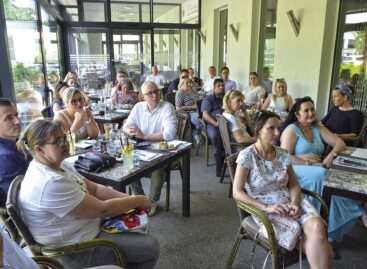FMCG is the most optimistic sector, but most retailers also expect a good year
According to Randstad’s labour market trends survey, which was published in January 2025, the food inflation of recent years is inspiring optimism in the FMCG industry in 2025, with three quarters expecting further growth, although most are only forecasting between 4% and 6%.
This article is available for reading in Trade magazin 2025/2-3.

Guest writer:
Sándor Baja
managing director
Randstad Hungary
This means that they calculate with revenues to be only a little higher than the level of the expected inflation. Last year two-thirds of food industry companies forecast growth, but this ratio has increased to three-quarters by now.
Retail and HoReCa are both much more optimistic
Last year less than half of retailers expected growth, but by now this proportion has reached 61%. While no one in FMCG predicts a bigger growth than 15%, in retail 15% are exactly at this level of optimism and the ratio of the most optimistic businesses is 7-10%. Last year only one in 11 retail companies wanted to recruit new workers, while this year 18% are forecasting growth. 57% plans to give employees a 6-10% pay rise and only one in 20 will go as high as 15%. The surveyed HoReCa firms (mostly hotel and restaurant chains) are the most optimistic in terms of business expectations after the FMCG sector: 71% predict growth – an increase of 13 percentage points compared to last year. As regards the whole market, we are below the post-pandemic bounce-back frenzy of 2022, when 61% of firms were hoping for growth, as now half of the companies surveyed expect sales to climb in 2025.
What do they expect in other sectors?
Logistics worries about hiking fuel prices, which they naturally want to pass on so they forecast above-average growth. IT/telecom, services and finance are less optimistic than last year. International economic downturn and the slowdown in public investment haven’t helped IT, while in the telecom sector there is healthy competition. Progress won’t stop as 52% of companies are planning to recruit in the IT sector. Services and finance would like to consolidate their strong positions and they aren’t pessimistic either. The situation in service centres is interesting: they are the least optimistic about their revenue growth (32%), but let’s not forget that they are largely exporters, which means they are paid in euros and dollars, so they will be quite well off due to the weakening of the forint. Service centres are among the most active in recruiting, with 48% looking to expand. Randstad’s centre in India has 1,400 employees and it has set up a new centre in Budapest, where we will do multilingual, high value-added in-house HR work such as recruitment and training and development.
Efficiency and salaries
It is a well-known fact that we Hungarians create less value per hour in purchasing power parity terms than Romanians, and we are far behind the Czechs – not to mention Germany. Raising the minimum wage seems like a good way to squeeze out efficiency and make non-viable businesses hand over their workers. It should be noted that the Romanians have raised the minimum wage twice in six months, and the one on 1 January is also slightly above the Hungarian rate: 9.5%. In Hungary one in 8 companies don’t replace those workers who leave, instead they increase efficiency, creating the background for wage increases. As inflation eases, firms are also lowering the rate of planned wage increases: 96% plan to raise wages this year and 87% in one step. 61% intends to increase salaries by 6-10% and one in 12 firms wish to give a pay raise between 11 and 15%. It is noteworthy that NONE of the companies surveyed can raise wages by more than 15%, while 62% of workers would like to see wage increases above 15%. The harsh reality of food prices and the cost of living clashes with the plans of firms.
Trendy topics: guest workers and AI
Economic rationality is secondary in Hungary, as it is well-indicated by the policy that doesn’t take into account demographic realities, the emigration of Hungarians and the international division of labour. By not allowing workers from outside the EU to stay in Hungary in the longer term, we are putting whole industries at risk. From the companies surveyed one in 11 would like to hire white-collar workers and one in 9 wants to recruit manual workers from outside the EU. AI is exploding: the number of companies using AI has increased from 19% to 28%. More than a third of businesses now provide AI training for their employees. Companies are using AI the most in administration, marketing and HR, but finance and customer service are also a focus. When Randstad employs 5,000 temporary workers in the Czech Republic during the Christmas season, it would be terribly difficult to serve them without AI and voice bots. //
Related news
Retailers turn to AI for marketing, merchandising
🎧 Hallgasd a cikket: Lejátszás Szünet Folytatás Leállítás Nyelv: Auto…
Read more >Year-end reflections and heart-warming thoughts!
🎧 Hallgasd a cikket: Lejátszás Szünet Folytatás Leállítás Nyelv: Auto…
Read more >A net, not a network: the art of networking
🎧 Hallgasd a cikket: Lejátszás Szünet Folytatás Leállítás Nyelv: Auto…
Read more >Related news
Experience, timing, awareness: a new travel logic is emerging towards 2026
🎧 Hallgasd a cikket: Lejátszás Szünet Folytatás Leállítás Nyelv: Auto…
Read more >The Temu model is at a turning point: extra-cheap online imports may become more expensive from 2026
🎧 Hallgasd a cikket: Lejátszás Szünet Folytatás Leállítás Nyelv: Auto…
Read more >Even though the price of cocoa has halved, chocolate will not become cheaper
🎧 Hallgasd a cikket: Lejátszás Szünet Folytatás Leállítás Nyelv: Auto…
Read more >






